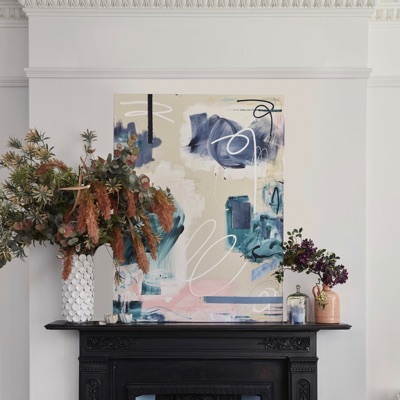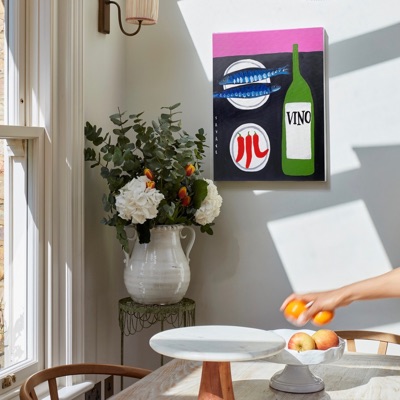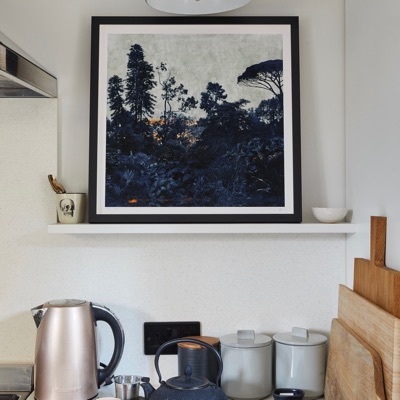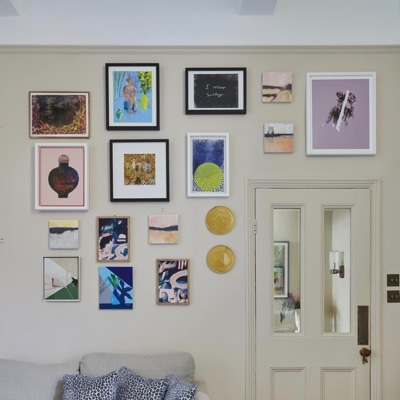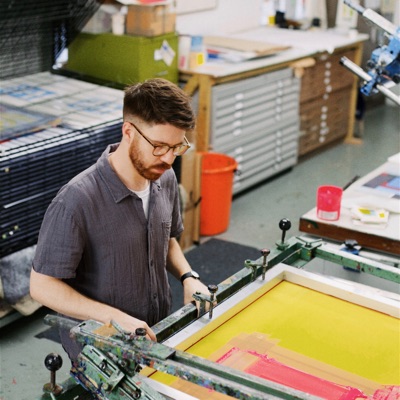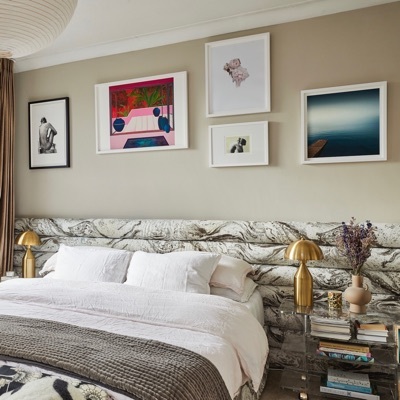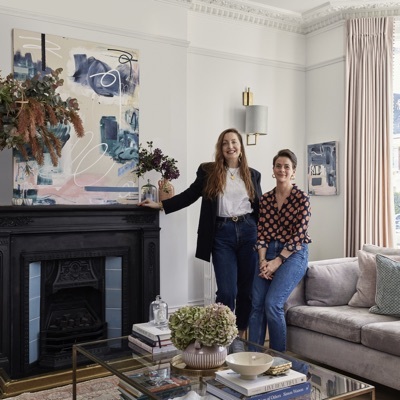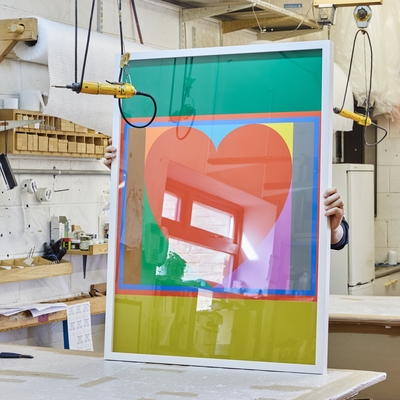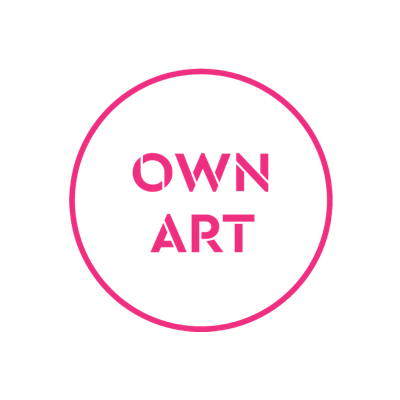Limited Edition Original Prints
Discover more about Limited Edition printmaking techniques.
Screenprint
Screenprint, also known as ‘silkscreen’ due to screens initially being made of silk – is most famed for the smooth, graphic shapes and flat colours it achieves.
The medium, although dating back more than 900 years to the Song dynasty in China, rose to prominence during the Pop Art movement of the 1950s. It has since become ubiquitous within contemporary culture, used to print movie posters, T-shirts, vinyl and extensively in advertising.
Screenprint is incredibly versatile, with many artists deploying it to create all types of painterly effects, in both figurative and abstract works. The technique is essentially a stencil print using a screen made from fabric stretched tightly over a frame.
A stencil may be achieved by painting on glue or lacquer, by applying adhesive film or paper, or by painting a light-sensitive polymer emulsion onto the screen, which is then developed as a photograph (known as a photo-screenprint).
Ink or paint is forced through the non-blocked areas of fabric mesh with a rubber blade – a squeegee – onto the paper below. Unlike most printing processes, which use oil-based inks, screenprint is done with acrylic, which is plastic-based and has a distinctive, bright look.
Explore our collection of screenprint art.
Linocut
Linocut is a form of ‘relief’ printmaking where shapes and lines are cut away from the material, and ink is applied to the remaining flat areas to create the finished image.
Created using linoleum – the same stuff that covers kitchen floors – it became popular with artists in the twentieth century, with pioneers including Edward Bawden, Cyril Power, Pablo Picasso and Paul Nash. It emerged as an alternative to traditional woodcut printing, largely because it is easier to cut than wood and has no grain.
Using specialist tools, the artist carves out an image in the lino and discards the pieces that have been cut away. Ink is then applied with a roller to the remaining raised areas, and the image is created on paper either by hand, by applying pressure (in its most rudimentary form the back of a spoon), or by feeding the paper and lino through a printing press. The paper is carefully peeled away to reveal the image.
There are different methods of linocutting – the ‘reduction’ method creates an image from the same sheet of lino, with shapes progressively cutaway between each colour; alternatively, an artist may use separate lino blocks for each colour, or a combination of the two.
While in theory, it may be as simple as a potato print, in practice creating a linocut is a painstaking process that can achieve a huge range of effects. The more colours and shapes that are printed, the more complex the process.
Lines may be immaculately graphic and sharp, and designs multilayered – see the architectural works of Paul Catherall for an example of masterful linocutting precision – or deliberately naïve in style to create a diversity of artworks. A skilled printmaker will be able to achieve wide variations in texture and tone.
Explore our range of linocut prints.
Etching
One of the most widely used methods of printmaking, etching is a technique that uses a chemical action to produce incised lines in a metal printing plate.
It is a form of printmaking known as ‘intaglio’, which is a design that is cut or engraved into another material, where the incised line or shape holds the ink. It is directly opposed to ‘relief’ printmaking where the shapes are cut away and the ink is held on the remaining flat surface (as with a linocut, for instance).
In pure etching, a metal – normally copper, zinc or steel – is covered with an acid-resistant wax or resin ‘ground’ (coating). The image is drawn through the coating with an etching needle, exposing the bare metal. The plate is then dipped in a bath of acid, which ‘bites’ into the metal where it has been exposed, leaving lines sunk into the plate.
The remaining coating is cleaned off the plate, and the plate is inked all over. The ink is then wiped off the surface, leaving only ink in the etched lines, which creates the image on paper when fed through a printing press.
Etching may also be combined with other intaglio techniques, such as ‘aquatint’ (a method of achieving tonal shading using powdered rosin rather than a needle) or engraving. There are many types of etching: ‘soft-ground’, using a non-drying coating to produce softer lines; ‘spit bite’, which involves painting or splashing acid onto the plate; ‘open bite’ in which areas of the plate are exposed to acid with no resistance; and ‘photo-etching’, produced by coating the plate with a light-sensitive emulsion and exposing this to light to reproduce a photographic image.
For examples of the ways in which etching methods can be adopted to achieve vastly diverse effects, see the immaculately detailed prints of Martin Langford, the softer forms and shapes of Jason Hicklin and the vibrant layers of Louise Davies.
Collagraph
‘Collagraph’ (sometimes ‘collagraph) is derived from the Greek ‘colla’, meaning glue, and ‘graph,’ meaning to draw. A collagraph is essentially a collage of materials of various textures glued onto a printing plate, often a thin wood or cardboard.
The plate is inked up, usually by hand, and then printed onto paper either manually or via a press. It is a form of relief printing that allows artists to create interesting marks and tonal effects due to the use of different materials – anything from lace to leaves, fabrics, cards, yarn and so on. It can be used alone or in conjunction with other printing processes, such as etching.
Collagraphs, due to the delicate nature of the card or thin wood plate, are often monoprints or short varied editions. We carry an exciting selection of work by printmakers who use this method in their work, from Vicky Oldfield to Paul Cleden and Corinna Button.
Monotype
A monotype print refers to a unique, or one-off, artwork. An image is painted in ink on a polished plate, such as glass or metal, and transferred to paper by pressing the two together – normally via the printing press.
Monotypes can also be created by inking the surface and, by using brushes, rags or other tools, creating areas of light from the solid opaque colour.
Morgan Doyle’s monotypes are made in this way by removing the ink with an etching needle, summoning images full of drama and energy. In his monotype ‘Untitled’, Doyle uses sand on the paper to further add depth and texture.
Explore our range of monotype prints.
Monoprint
A monoprint is any form of printmaking where the image can only be created once, rather than in a limited edition run of several prints.
It may refer to a print created via other techniques (such as linocut, etching or woodblock) where unique hand colouring or collage is applied on top to render it a one-off, or to an etching that is inked and wiped in a not precisely repeatable manner.
For an example of the process at play, see Bruce McLean’s vibrant monoprint series ‘Son Carigol’.
Explore our range of monoprints.
Lithograph
Lithography – which means, literally, ‘stone drawing’ – is a printing method that uses a flat polished stone or metal plate and is based on the notion that grease and water don’t mix.
It was developed in the late 18th century, initially using Bavarian limestone for commercial printing of musical scores – although aluminium is often used today.
A drawing is made on the stone or plate using a greasy crayon or ink. A solution of gum arabic and nitric acid is then applied over the entire surface, ‘fixing’ the design on to the stone. Water is applied to the plate and is absorbed everywhere except where repelled by the greasy image.
A roller dipped in oil-based ink is then rolled over it, with ink only sticking to the greasy areas. The image is transferred on to paper lightly via a printing press, creating neither a raised nor embossed effect but one where the ink lies entirely on the surface of the paper. The design may be produced in one colour from a single stone, or divided among several stones to create, via multiple printing, a litho in more than one colour.
Woodcut
Woodcut is a ‘relief’ printing technique where the artist carves away a design and ink is applied to the remaining flat area. Used for centuries as a method for printing on textiles, and later paper, throughout East Asia and especially Japan, it spread to Europe in the late 13th century.
To produce a woodcut print, the artist creates an image on the surface of a block of wood and any unwanted areas are carved away. Ink is applied over the surface with a rubber roller and the design printed onto paper. Multiple colours can be added, each one applied using a separate wood block. To ensure each colour appears in the same place, the paper or cloth is keyed to a frame around each block.
Woodcut is favoured by many artists such as Alex Booker, for the earthy and textural quality the grain of wood leaves on the image.
Explore our woodcut prints here.
Digital
The term ‘digital art’ was first coined in the early 1980s, when the British-born artist Harold Cohen began creating work using a computer program. His robotic machine became known as AARON, and was designed to make large drawings on sheets of paper placed on the floor.
With rapid advances in technology over the past 30 or 40 years, digital art can now encompass computer-generated or scanned artwork as well as those produced via tablet, smartphone or mouse. Artists may create moving visual collages, digital installations and interactive pieces, allowing the audience to participate in the creative process.
Along with Cohen, one of the key pioneers of the medium has been David Hockney, who creates his work with Brushes, an App built by former Apple software engineer Steve Sprang. Hockney has long been fascinated by new media, buying one of the first colour photocopying machines in the mid-1980s to create a series of works entitled Hand-Made Prints.
Today, he works on iPhone and iPad, waxing lyrical about the “marvellous flow” of the medium: “So much variety is possible. You can’t overwork this, because it’s not a real surface. In watercolour, for instance, about three layers are the maximum. Beyond that it starts to get muddy. Here you can put anything on anything. You can put a bright, bright blue on top of an intense yellow.”
He insists: “Picasso would have gone mad with this. So would Van Gogh. I don’t know an artist who wouldn’t.”
Explore our digital art.
